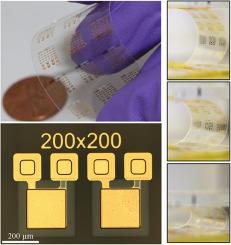Microelectronic Engineering ( IF 2.6 ) Pub Date : 2021-08-23 , DOI: 10.1016/j.mee.2021.111618 Ovidio Rodriguez-Lopez 1, 2 , Edgar Guerrero Ruiz 3 , Alexander J. Polednik 3 , Adriana C. Duran-Martinez 1 , Aldo Garcia-Sandoval 1 , Walter Voit 1, 3 , Gerardo Gutierrez-Heredia 4

|
In this work, we investigate the electrical performance and compatibility of low-temperature hafnium oxide (HfO2) thin-film capacitors on a novel softening polymer substrate. Metal-insulator-metal HfO2 capacitors were fabricated using HfO2 as the dielectric material, deposited at 100 °C by atomic layer deposition (ALD), and gold as the top and bottom contacts. The HfO2 capacitors were fabricated on silicon and on softening polymer substrates with a dielectric thickness of 50, 40, 30, and 20 nm. The electrical performance of the MIM capacitors was measured and compared to determine the quality and compatibility of the low-temperature HfO2 deposition with the silicon and polymer substrate. The dielectric constant varied from 12 to 17 as the HfO2 thickness increased from 20 to 50 nm. Moreover, the capacitance density and dielectric constant of the capacitors on the polymer substrate differed by 3.9% ± 2% and 3.4% ± 2% with respect to the silicon substrate. The polymer substrate devices also have a higher leakage current, which suggests a higher number of defects in the dielectric film relative to Si substrates. Finally, the devices on the polymer substrate were subjected to bending cycles (up to 105 cycles) with a 5 mm bending radius to evaluate the resilience of the HfO2 capacitors against mechanical stress. The results show that the fabrication of the HfO2 thin-film capacitors on the softening polymer substrate is achievable with high stability and mechanical resilience. Overall, this research could assist the production of flexible biomedical devices on softening polymer substrates.
中文翻译:

可变形软化聚合物基板上柔性氧化铪电容器的电气特性
在这项工作中,我们研究了低温氧化铪 (HfO 2 ) 薄膜电容器在新型软化聚合物基板上的电气性能和兼容性。金属-绝缘体-金属 HfO 2电容器使用 HfO 2作为介电材料制造,通过原子层沉积 (ALD) 在 100 °C 下沉积,金作为顶部和底部触点。HfO 2电容器是在硅和软化聚合物基板上制造的,其介电厚度为 50、40、30 和 20 nm。测量并比较 MIM 电容器的电气性能,以确定低温 HfO 2的质量和兼容性用硅和聚合物基板沉积。随着 HfO 2厚度从 20 增加到 50 nm ,介电常数从 12 变化到 17 。此外,聚合物基板上电容器的电容密度和介电常数相对于硅基板分别相差 3.9%±2% 和 3.4%±2%。聚合物衬底器件还具有更高的漏电流,这表明相对于硅衬底而言,介电膜中的缺陷数量更多。最后,聚合物衬底上的器件经受 弯曲半径为5mm的弯曲循环(最多10 5个循环)以评估HfO 2电容器抵抗机械应力的弹性。结果表明,HfO 2的制备软化聚合物基板上的薄膜电容器具有高稳定性和机械弹性。总的来说,这项研究可以帮助在软化聚合物基材上生产柔性生物医学设备。











































 京公网安备 11010802027423号
京公网安备 11010802027423号